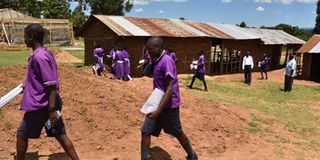Why free education has buzzword in past two decades

Pupils at the compound of Shikokhwe Primary School in Malava, Kakamega County. PHOTO | ISAAC WALE | NATION MEDIA GROUP
What you need to know:
- The government has allocated some Sh25 billion for free day secondary education.
- Free primary and subsidised secondary education have suffered from poor funding.
A recent Daily Nation front page picture of dilapidated classrooms at Shikokhwe Primary School in Malava, Kakamega County, published last week set the country abuzz.
It was a graphic illustration of the depravity witnessed in many public primary schools across the country.
It demonstrated dereliction of duty, absence of urgency and lack of commitment to provision of quality education.
Provision of free primary and secondary education has become a buzzword in the past two decades.
CAMPAIGNS
Since the World Conference on Education For All in Dakar, Senegal, in 2000 that mobilised international campaign and support for universal basic education, national governments have anchored it in their national development plans. Politicians seeking office dutifully leverage on it for their campaigns.
Kenya under the National Rainbow Coalition (Narc) launched free primary education in 2003 and subsequently subsidised secondary education in 2008.
Now, the Jubilee Party has announced plans to make secondary education fully free for day scholars from January. Effectively, this will mean that all Standard Eight leavers who meet secondary education entry point will automatically transit to Form One.
The essence of government’s subsidy is to make education accessible to all eligible children. Underpinning this is the fact access to education is a fundamental human right. But the question is; are we ready for quality free day secondary schooling starting next year?
So far, the government has allocated some Sh25 billion for free day secondary education. By all counts, this is a major boost.
SUBSIDISED
A circular released last month by Education PS Belio Kipsang’ stated that the government will spend Sh22,244 for every child in secondary school, which essentially covers all the costs for day school.
However, boarders will pay a pro-rated fee depending on the classification of schools. National and extra-county (formerly provincial schools) will charge Sh53,544 while the rest of the boarding schools, Sh40,535.
From the experience of the past decade, free primary and subsidised secondary education have suffered from poor funding.
In the past, the government allocated Sh1,020 for every primary school child and Sh10,500 for secondary schools, which was then raised to Sh12,870.
For primary schools, other than the first two years, 2003 – 2005, the schools have seldom received the full capitation.
Neither has it worked for the subsidised secondary education. Moreover, even the part-payment never comes on time.
For example, cash for the third term only came late in October when the schools were nearly closing and after protests by principals and teachers’ unions.
TASKFORCE
Related to this, schools are in dire need of facilities as illustrated by Shikokhwe, yet cash for such capital development is not factored in government expenditures.
In 2014, then Education Cabinet Secretary Jacob Kaimenyi appointed a taskforce chaired by Dr Kilemi Mwiria to investigate and make recommendations on secondary school fees.
In its findings, the taskforce indicated that providing free day secondary education would cost the government Sh51.5 billion a year for an enrolment of 2.1 million students. Further, it would require additional 4,222 secondary schools to accommodate all those eligible students.
Even if we discount the fact that this estimates are four years old, the proposed Sh25 billion is just half of what is required to roll out free day secondary programme.
Matters will be made worse because of minimal allocations earmarked for capital development.
Second, is teacher sufficiency. Conservative statistics indicate that there is a shortage of some 87,000 teachers, the bulk, about 50,000 in primary schools.
However, there is a general freeze on teacher recruitment and instead, the government only replaces those who exit the profession.
UNRESOLVED
This year, it is recruiting only 5,000 teachers to fill those vacancies.
Third, the question of teaching and learning resources remain unresolved.
On paper, the government makes allocation for textbooks and other resource materials, but in reality they are hardly bought.
What does it take to achieve quality free primary and secondary education? One, Education ministry should delegate to the county governments the responsibility of providing school infrastructure.
Two, conduct regular audit on the use of cash.
Three, since the Ministry is taking over learning costs, the management of bursaries currently under MPs should be reviewed.
Four, intensify school inspection and five, review teacher recruitment and deployment.




